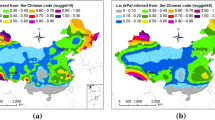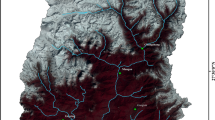Abstract
Snow depth records from daily measurements at climatological stations were obtained from Environment Canada and were processed and analyzed. It was identified that there are 549 stations, each with at least 20 years of useable annual maximum snow depth data. Both the Gumbel distribution and generalized extreme value distribution were used to fit the annual maximum snow depth, considering several distribution fitting methods. Statistical analysis results indicated that, according to the Akaike information criterion, the Gumbel distribution is preferred for 72 % stations. The estimated return period value of annual maximum snow depth at stations was used to calculate their corresponding ground snow load. The at-site analysis results were used as the basis to spatially interpolate the ground snow loads for locations tabulated in the National Building Code of Canada (NBCC) since a code location and a climatological site are usually not co-located. For the interpolation, the ordinary co-kriging method with elevation as co-variate was used because a cross-validation analysis by using several deterministic and probabilistic spatial interpolation techniques indicated that the ordinary co-kriging method is preferred. A comparison of the newly estimated ground snow loads to those locations tabulated in the 1995 edition and 2010 edition of the NBCC was also presented.











Similar content being viewed by others
References
Akaike H (1974) A new look at the statistical model identification. IEEE Trans Autom Control 19(6):716–723
Blanchet J, Davison AC (2011) Spatial modelling of extreme snow depth. Ann Appl Stat 5:1699–1725
Blanchet J, Lehning M (2010) Mapping snow depth return levels: smooth spatial modeling versus station interpolation. Hydrol Earth Syst Sci 14(12):2527–2544
Boyd DW (1961) Maximum snow depths and snow loads on roofs in Canada. Division of Building Research, Research Paper No. 142, National Research Council, Ottawa, Ont. In: Proceedings of the Western Snow Conference, pp. 6–16, April
Castillo E (1988) Extreme value theory in engineering. Academic Press, New York
Chiles J, Delfiner P (1999) Geostatistics-modeling spatial uncertainty. Wiley, New York
Coles S (2001) An introduction to statistical modeling of extreme values. Springer, London
Cressie N (1993) Statistics for spatial data. Wiley, New York
Cunnane C (1978) Unbiased plotting-positions—A review. J Hydrol 37:205–222. doi:10.1016/0022-1694(78)90017-3
Durmaz M, Daloğlu AT (2006) Frequency analysis of ground snow data and production of the snow load map using geographic information system for the Eastern Black Sea region of Turkey. ASCE J Struct Eng 132(7):1166–1177
Ellingwood B (1984) Probabilistic models for ground snow accumulation. In: Proceedings, Eastern Snow Conference, Vol. 29, 41st Annual Meeting, Washington, DC, pp. 49–58
Hong HP, Li SH, Mara T (2013) Performance of the generalized least-squares method for the extreme value distribution in estimating quantiles of wind speeds. J Wind Eng Ind Aerodyn. 10.1016/j.jweia.2013.05.012i
Hosking J, Wallis J, Wood E (1985) Estimation of the generalized extreme-value distribution by the method of probability-weighted moments. Technometrics 27:251–261
Johnston K, Ver Hoef JM, Krivoruchko K, Lucas N (2003) ArcGIS 9, using ArcGIS geostatistical analyst. Environmental Systems Research Institute, Redlands
Lowery MD, Nash JE (1970) A comparison of methods of fitting the double exponential distribution. J Hydrol 10:259–275
Martin ES, Stedinger JR (2000) Generalized maximum-likelihood generalized extreme-value quantile estimators for hydrologic data. Water Res Res 36:737–744
Newark MJ (1984) A new look at ground snow loads in Canada. In: Proceedings, Eastern Snow Conference, Vol. 29, 41st Annual Meeting, Washington, DC, pp. 37–48
Newark MJ, Welsh LE, Morris RJ, Dnes WV (1989) Revised ground snow loads for the 1990 National Building Code of Canada. Can J Civ Eng 16:267–278
NRCC (1990) National Building Code of Canada. Institute for Research in Construction, National Research Council of Canada, Ottawa
NRCC (1995) National Building Code of Canada. Institute for Research in Construction, National Research Council of Canada, Ottawa
NRCC (2005) National Building Code of Canada. Institute for Research in Construction, National Research Council of Canada, Ottawa
NRCC (2010) National Building Code of Canada. Institute for Research in Construction, National Research Council of Canada, Ottawa
Thomas HK (1955) A method of computing maximum Snow loads. Eng J 38(2):120–123
Acknowledgments
The authors gratefully acknowledge comments and suggestions from the National Building Code of Canada Part 4 Task Group on Climatic Loads: P.A. Irwin (Chair), H. Auld, B. Baskaran, M. Buckley, G.A. Fenton, P. Jarrett, G. A. Kopp, R. J. Morris, G. Newfield and C. Taraschuk. The opinions expressed in this paper are those of the authors, however, and not necessarily those of the Task Group. The authors are grateful to R. J. Morris and P. L. Jarrett from Environment Canada for providing snow records, as well as providing helpful advices and several valuable references.
Author information
Authors and Affiliations
Corresponding author
Rights and permissions
About this article
Cite this article
Hong, H.P., Ye, W. Analysis of extreme ground snow loads for Canada using snow depth records. Nat Hazards 73, 355–371 (2014). https://doi.org/10.1007/s11069-014-1073-z
Received:
Accepted:
Published:
Issue Date:
DOI: https://doi.org/10.1007/s11069-014-1073-z




